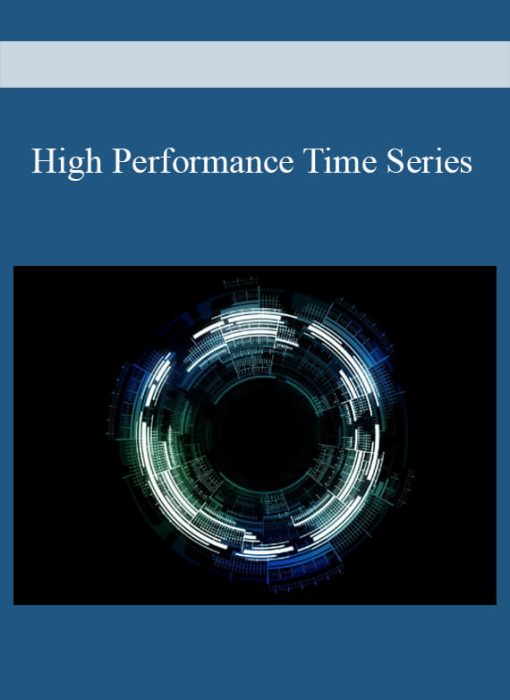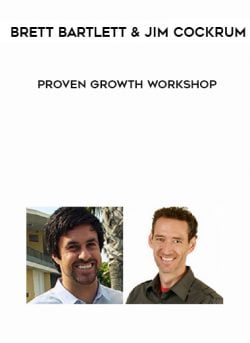High Performance Time Series
Original price was: $709.00.$162.00Current price is: $162.00.
Product Delivery – You will receive Content Access Via Email.
Email – Kickmarketers@gmail.com
Description
High Performance Time Series
High Performance Time Series
Become the time-series domain expert for your organization
Become the Time Series Expert for your organization
The High-Performance Time Series Forecasting Course is an amazing course designed to teach Business Analysts and Data Scientists how to reduce forecast error using state-of-the-art forecasting techniques that have won competitions. You’ll undergo a complete transformation learning the most in-demand skills that organizations need right now. Time to accelerate your career.
Crafted For Business Analysts & Data Scientists
That need to reduce forecasting error and scale results for your organization.
This is possibly my most challenging course ever. You’ll learn the time series skills that have taken me 10-years of study, practice, and experimentation.
My talk on High-Performance Time Series Forecasting
This course gives you the tools you need to meet today’s forecasting demands.
A full year was spent on building two of the software packages you’ll learn, modeltime and timetk .
Plus, I’m teaching you GluonTS , a state-of-the-art deep learning framework for time series written in python.
This course will challenge you. It will change you. It did me.
– Matt Dancho, Course Instructor & Founder of Business Science
Undergo a Complete Transformation
By learning forecasting techniques that get results
With High-Performance Forecasting, you will undergo a complete transformation by learning the most in-demand skills for creating high-accuracy forecasts.
Through this course, you will learn and apply:
- Machine Learning & Deep Learning
- Feature Engineering
- Visualization & Data Wrangling
- Transformations
- Hyper Parameter Tuning
- Forecasting at Scale (Time Series Groups)
How it works
Your path to becoming an Expert Forecaster is simplified into 3 streamlined steps.
1
Time Series Feature Engineering
2
Machine Learning for Time Series
3
Deep Learning for Time Series
Part 1
Time Series Feature Engineering
First, we build your time series feature engineering skills. You learn:
- Visualization: Identifying features visually using the most effective plotting techniques
- Data Wrangling: Aggregating, padding, cleaning, and extending time series data
- Transformations: Rolling, Lagging, Differencing, Creating Fourier Series, and more
- Feature Engineering: Over 3-hours of content on introductory and advanced feature engineering
Part 2
Machine Learning for Time Series
Next, we build your time series machine learning skills. You learn:
- 17 Algorithms: 8 hours of content on 17 TOP Algorithms. Divided into 5 groups:
- ARIMA
- Prophet
- Exponential Smoothing – ETS, TBATS, Seasonal Decomposition
- Machine Learning – Elastic Net, MARS, SVM, KNN, Random Forest, XGBOOST, Cubist, NNET & NNETAR
- Boosted Algorithms – Prophet Boost & ARIMA Boost
- Hyper Parameter Tuning: Strategies to reduce overfitting & increase model performance
- Time Series Groups: Scale your analysis from one time series to hundreds
- Parallel Processing: Needed to speed up hyper parameter tuning and forecasting at scale
- Ensembling: Combining many algorithms into a single super learner
Part 3
Deep Learning for Time Series
Next, we build your time series deep learning skills. You learn:
- GluonTS: A state-of-the-art forecasting package that’s built on top of mxnet (made by Amazon)
- Algorithms: Learn DeepAR, DeepVAR, NBEATS, and more!
Challenges & Cheat Sheets
Next, we build your time series machine learning skills. You learn:
- Cheat Sheets: Developed to make your forecasting workflow reproducible on any problem
- Challenges: Designed to test your abilities & solidify your knowledge
Summary of what you get
- A methodical training plan that goes from concept to production ($10,000 value)
- Part 1 – Feature Engineering with Timetk
- Part 2 – Machine Learning with Modeltime
- Part 3 – Deep Learning with GluonTS
- Challenges & Cheat Sheets
Your Instructor
Founder of Business Science and general business & finance guru, He has worked with many clients from Fortune 500 to high-octane startups! Matt loves educating data scientists on how to apply powerful tools within their organization to yield ROI. Matt doesn’t rest until he gets results (literally, he doesn’t sleep so don’t be suprised if he responds to your email at 4AM)!
Course Curriculum
- High-Performance Time Series – Become the Time Series Expert for Your Organization (2:34)
- Private Slack Channel – How to Join
- Video Subtitles (Captions)
- What is a High-Performance Forecasting System?
- [IMPORTANT] System Requirements – R + Python Requirements & Common Issues
- Prerequisite – Data Science for Business Part 1
- Getting Help (IMPORTANT!!!)
- High-Performance Forecasting – What You’re Learning, Why You’re Learning It (0:43)
- The Forecasting Competition Review & Course Progression (3:34)
- 2014 Kaggle Walmart Recruiting Challenge (5:11)
- 2018 M4 Competition (3:37)
- 2018 Kaggle Wikipedia Website Traffic Forecasting Competition (4:30)
- 2020 M5 Competition (5:59)
- 5 Key Takeaways from the Forecast Competition Review (5:41)
- The Business Case – Developing a Best-in-Class Forecasting System (3:03)
- Timetk: Time Series Data Preparation, Visualization, & Preprocessing (5:54)
- Modeltime: Time Series Machine Learning (5:25)
- GluonTS: Time Series Deep Learning (2:01)
- ?️ [Cheat Sheet] Forecasting Workflow
- Time Series Jump (0:54)
- Project Setup (2:28)
- Course Data (File Download) (1:02)
- R Package Installation – Part 1 (File Download) (5:26)
- R Package Installation – Part 2 (5:14)
- Jump Setup (File Download) (0:44)
- Establish Relationships, Part 1 – Google Analytics Summary Dataset (4:11)
- Establish Relationships, Part 2 – Google Analytics Top 20 Pages (5:23)
- Build Relationships – Mailchimp & Learning Lab Events (4:49)
- Generate Course Revenue – Transaction Revenue & Product Events (3:03)
- Code Checkpoint (File Download) (0:54)
- Read This! – Time Series Jump Intent
- Time Series Jump – Setup (File Download) (3:20)
- Libraries & Data (3:13)
- EDA for Time Series (1:08)
- Summarize By Time (5:46)
- Time Series Summary Diagnostics (4:47)
- Pad by Time (4:08)
- Visualize the Time Series (3:12)
- Evaluation Window – Filter By Time (4:43)
- Time Series Train/Test Split (4:53)
- Training a Prophet Model with Modeltime (4:21)
- Modeltime Forecasting Workflow – Round 1 (7:43)
- Visualizing Seasonality (4:34)
- Feature Engineering – Part 1 (5:45)
- Feature Engineering – Part 2 (5:51)
- Machine Learning with Workflows (3:35)
- Modeltime Forecasting Workflow – Round 2 (5:59)
- Here’s where you are going. (3:11)
- Code Checkpoint (File Download)
- Welcome to Part 1 – Time Series with Timetk! (2:17)
- Setup (File Download) & Overview – Visualization (2:11)
- Data Preparation – Part 1 (4:29)
- Data Preparation – Part 2 (3:23)
- [MUST KNOW] Plotting Time Series ? (5:31)
- Plotting with Transformations (4:37)
- Adjusting the Smoother (6:11)
- Smoother for Groups (1:54)
- Interactive & Static Plots (2:00)
- ACF & PACF Concepts – Autocorrelation & Partial Autocorrelation
- ACF & PACF Plotting (7:49)
- Lag Adjustment (1:24)
- CCF Plotting – Cross Correlations (7:58)
- Seasonality Box Plot (5:52)
- Seasonality Violin Plot (0:53)
- Anomaly Plot Basics (4:50)
- Getting the Anomaly Data (2:00)
- Working with Grouped Data (1:43)
- STL Decomposition Plot (4:44)
- STL Decomposition – Grouped Time Series (2:11)
- [SECRET WEAPON] Time Series Regression Plot ??? (7:08)
- Time Series Regression Plot – Grouped Time Series (4:05)
- Code Checkpoint (File Download)
- Setup (File Download) & Overview – Data Wrangling (2:34)
- Single & Grouped Time Series Summarizations (4:37)
- Using Across (to Summarize Wide-Format Tibbles by Time) (5:11)
- Weekly/Monthly/Quarterly/Yearly Aggregations (3:33)
- Floor, Ceiling, Round (5:15)
- Filling in Gaps (2:54)
- From Low-Frequency to High-Frequency (3:36)
- Zooming & Slicing (5:14)
- Offsetting by Time (2:01)
- Extrapolate the Mean, Median, Max, Min By Time (7:57)
- Combining Subscribers & Web Traffic (3:48)
- Inspecting the Join (3:00)
- Formatting the Join for Feature Relationships (5:49)
- Join Cross Correlations (3:22)
- Making a Time Series (4:39)
- Making a Holiday Sequence (3:14)
- Time Offsets (3:01)
- Making a Future Time Series (3:12)
- The Future Frame (2:47)
- [FORECAST SPOTLIGHT] Forecasting with the Future Frame ? (6:53)
- Code Checkpoint (File Download)
- Setup (File Download) & Overview – Transformations (2:15)
- Libraries & Data (2:12)
- Why is Variance Reduction Important? (4:43)
- Log – Log (and Log1P) Transformation (4:17)
- Log – Assessing the Benefit of Log1P Transformation (2:51)
- Log – Groups & Inversion (3:43)
- Box Cox – What is the Box Cox Transformation? (2:34)
- Box Cox – Assessing the Benefit (4:04)
- Box Cox – Inversion (2:05)
- Box Cox – Managing Grouped Transformations & Inversion (8:36)
- Introduction to Rolling & Smoothing (1:49)
- Rolling Windows – What is a Moving Average? (File Download) (3:53)
- Rolling Windows – Moving Average & Median Applied (8:53)
- Loess Smoother (7:02)
- Rolling Correlation – Slidify, Part 1 (4:16)
- Rolling Correlation – Slidify, Part 2 (7:40)
- [BUSINESS SPOTLIGHT] The Problem with Forecasting using a Moving Average (6:43)
- Introduction to Normalization & Standardization (0:59)
- What is Normalization? [Min = 0, Max = 1] (4:50)
- What is Standardization? [Mean = 0, Standard Deviation = 1] (2:31)
- Introduction to Imputation & Outlier Cleaning (0:44)
- Imputation – Time Series NA Repair (6:40)
- Anomalies – Time Series Outlier Cleaning (7:22)
- Anomalies – When to Remove Outliers (5:21)
- Introduction to Lags & Differencing (1:08)
- Lags – What is a Lag? (1:49)
- Lags – Lag Detection with ACF/PACF (3:54)
- Lags – Regression with Lags (5:06)
- Differencing – Growth vs Change (4:00)
- Differencing – Acceleration (6:22)
- Differencing – Comparing Multiple Time Series (4:44)
- Differencing – Inversion (0:57)
- Introduction to the Fourier Series (7:23)
- Fourier Regression (4:24)
- What is the Log Interval Transformation? (5:47)
- Visualizing the Transformation (4:12)
- Transformations & Preprocessing (5:09)
- Modeling (6:29)
- Preparing Future Data (3:36)
- Making Predictions (1:05)
- Combining the Forecast Data (4:08)
- Estimating Confidence Intervals (8:24)
- Visualizing Confidence Intervals (2:10)
- Inverting the Log Interval Transformation (4:08)
- Code Checkpoint (File Download)
- Challenge #1 Discussion (File Download) (4:21)
- Solution – Part 1 (File Download) (7:18)
- Solution – Part 2: Begins at “Identify Relationships” (7:51)
- Setup (File Download) & Overview – Intro to Feature Engineering (2:30)
- Data Prep, Part 1 – Log Standardize (5:27)
- Data Prep, Part 2 – Getting Ready to Clean (5:01)
- Data Prep, Part 3 – Targeted Cleaning with Between Time (4:18)
- The Time Series Signature (7:55)
- Feature Removal (3:28)
- Linear Trend (2:10)
- Non-Linear Trend – Basis Splines (4:41)
- Non-Linear Trend – Natural Splines (Stiffer than Basis Splines) (4:29)
- Seasonal Features – Weekday & Month (3:21)
- Seasonal Features – Combining with Trend (5:23)
- Interaction Features – Spikes Every Other Wednesday (7:35)
- Selecting & Adding Fourier Frequency Features (4:21)
- Modeling & Visualizing the Fourier Effects (2:07)
- Selecting & Adding Lag Features (6:59)
- Modeling & Visualizing the Lag Effects (5:20)
- Preparing Event Data for Analysis (6:34)
- Visualizing Events (2:57)
- Modeling & Visualizing Event Effects (2:08)
- Fixing the Spline (2:07)
- Transforming Xregs (5:05)
- Joining Xregs (1:49)
- Examining Cross Correlations (1:53)
- Modeling with Xregs (3:28)
- Visualizing PageViews vs Optins & Modeling Lags (6:58)
- Collecting the Recommended Model (3:44)
- Saving the Model Artifact (2:28)
- Code Checkpoint (File Download)
- Forecasting Workflow [CHEAT SHEET] ?️ (3:40)
- Setup (File Download) & Overview – Advanced Feature Engineering (1:43)
- Data Preparation (4:42)
- The “Full” Dataset (2:50)
- Extending – Future Frame (3:21)
- Adding Lag Features (4:02)
- Add Lagged Rolling Features (5:03)
- Add Events (External Regressors) (2:57)
- Format Column Names (3:09)
- Data Prepared / Future Data Split (2:48)
- Train / Test Split (3:55)
- Recipes Intro (2:41)
- Step – Time Series Signature Features (5:48)
- Step – Feature Removal (3:10)
- Step – Standardization (2:11)
- Step – One-Hot Encoding (1:55)
- Step – Interaction Features (2:28)
- Step – Fourier Series Features (2:03)
- Model Spec: LM Model (1:02)
- Recipe Spec: Spline Features (5:59)
- Workflow: Spline Recipe + LM Model (2:49)
- Modeltime Table & Calibration (2:08)
- Forecasting the Test Data (2:40)
- Measuring the Test Accuracy (1:19)
- Comparing the Training & Testing Accuracy (1:32)
- Recipe Spec: Lag Features (3:00)
- Workflow: Lag Recipe+ LM Model (2:40)
- Modeltime: Comparing Spline & Lag Models (4:23)
- Refitting the Models (4:37)
- Transformation Inversion (5:23)
- Visualizing the Forecast in the Original Scale (1:59)
- Creating an Artifact List, Part 1 (4:34)
- Creating an Artifact List, Part 2 (3:11)
- Organizing the Artifacts List (1:57)
- Saving the Artifacts (1:28)
- Code Checkpoint (File Download)
- Challenge Discussion, Part 1 (File Download) – Feature Preparation (5:11)
- Challenge Discussion, Part 2 – Feature Engineering & Modeling (4:56)
- Solution, Part 1 (File Download) – Collect & Prepare Data (3:49)
- Solution, Part 2 – Visualizations (3:19)
- Solution, Part 3A – Create Full Dataset (5:46)
- Solution, Part 3B – Visualize the Full Dataset (3:47)
- Solution, Part 4 – Model/Forecast Data Split (1:05)
- Solution, Part 5 – Train/Test Data Split (0:56)
- Solution, Part 6 – Feature Engineering (4:18)
- Solution, Part 7 – Modeling: Spline Model (6:08)
- Solution, Part 8 – Modeling: Lag Model (2:25)
- Solution, Part 9 – Modeltime (4:03)
- Solution, Part 10 – Forecast (6:49)
- Regularization, Part 1 (File Download) – Model: GLMnet (4:01)
- Regularization, Part 2 – Improving the Lag Model with GLMNet (5:28)
- Regularization, Part 3 – Forecasting the Future Data with GLMNet + Lag Recipe (3:02)
- WOOO HOOO – You crushed it!
- Picking Up From Part 1 (Project Download)
- Setup – Modeltime Workflow [In-Depth] (1:25)
- Overview – Modeltime Workflow [In-Depth] (1:16)
- Libraries & Artifacts Preparation (2:33)
- Model Requirements for Modeltime (1:34)
- Parsnip Object Models – Univariate (3:37)
- Workflow Objects – Multivariate, Date-Based Features (7:14)
- Workflow Object – Multivariate, External Features (4:53)
- Modeltime Table – Key Requirements (4:27)
- Calibration Table – How It Works (3:29)
- Primary Accuracy Metrics & Uses [SUPER IMPORTANT] (7:40)
- Custom Metric Sets using Yardstick (3:54)
- Customizing the Accuracy Table Output (3:28)
- Modeltime Forecast – How It Works (6:22)
- Customizing the Forecast Visualization (5:00)
- Refitting – How It Works (3:02)
- Making the Forecast (5:20)
- Code Checkpoint (File Download)
- Setup (File Download) – Modeltime New Features (1:53)
- Expedited Forecasting – Modeltime Table (5:20)
- Expedited Forecasting – Skip Straight to Forecasting (2:20)
- Visualizing a Fitted Model (2:57)
- Calibration – In-Sample vs Out-of-Sample Accuracy (5:25)
- Residual Diagnostics – Getting Residuals (2:16)
- Residuals – Time Plot (2:39)
- Residuals – Plot Customization (2:29)
- Residuals – ACF Plot (4:06)
- Residuals – Seasonality Plot (3:50)
- Code Checkpoint (File Download)
- Setup (File Download) (0:40)
- ARIMA Training Overview (1:29)
- Libraries & Artifacts Setup (1:49)
- Auto-Regressive Functions: ar() & arima() (5:15)
- Auto-Regressive (AR) Modeling with Linear Regression (3:11)
- Single-Step Forecast for AR Models (4:43)
- Multi-Step Recursive Forecasting for AR Models (4:44)
- Integration (Differencing) (5:42)
- Moving Average (MA) Process (Error Modeling) (7:36)
- Seasonal ARIMA (SARIMA) (4:29)
- Adding XREGS (SARIMAX) (4:44)
- Setting Up Basic ARIMA in Modeltime (4:45)
- Trying Different ARIMA Parameters (5:11)
- About AIC (Akaike Information Criterion) (3:42)
- Implementing Auto ARIMA in Modeltime (1:49)
- How Auto ARIMA Works – Lazy Grid Search (1:27)
- Comparing ARIMA & Auto ARIMA (3:15)
- Adding Fourier Features to Pick Up More than 1 Seasonality (3:49)
- Adding Event Features to Improve R-Squared (Variance Explained) (1:33)
- Refitting & Reviewing the Forecast (2:57)
- Adding Month Features to Account for February Increase – BEST MAE 0.564 (3:35)
- ARIMA Strengths & Weaknesses (and Strategies that Worked) (3:56)
- Saving Artifacts – Best ARIMA Model (3:28)
- Code Checkpoint (File Download)
- Setup (File Download) (0:27)
- Prophet Training Overview (0:51)
- Libraries & Artifacts (2:02)
- Prophet Regression: prophet_reg() (3:23)
- Modeltime Workflow (2:02)
- Adjusting the Key Prophet Parameters (5:13)
- Extracting the Prophet Model from Modeltime (3:11)
- Visualizing the Effect of Key Parameters on the Prophet Model (5:48)
- Understanding Prophet Components & Additive Model (2:37)
- Fitting Prophet w/ Events (2:19)
- Comparing No Events vs Events – BEST MAE 0.488 (w/ Events) ? (3:05)
- Making the Forecast (2:10)
- Logging (Saving) Your Progress (2:40)
- Recap – Prophet Strengths & Weaknesses (3:02)
- Code Checkpoint (File Download)
- Setup (File Download) (0:18)
- Overview – Exponential Smoothing (0:35)
- Libraries & Artifacts (1:37)
- The Exponential Weighting Function (4:50)
- Applying the Exponential Weighting Function to Make a Forecast (2:41)
- ETS Model: exp_smoothing() (3:52)
- Visualizing the ETS Model (4:48)
- TBATS Model: seasonal_reg() (3:36)
- Visualizing the TBATS Model (2:48)
- Seasonal Decomposition & Multiple Seasonality Time Series (MSTS) Objects (2:28)
- STLM ETS Model (2:33)
- STL Plot & Relationship to STLM ETS Model (2:49)
- STLM ARIMA Model (1:55)
- STLM ARIMA – Adding XREGS (1:08)
- Preparing the Test Forecast Visualization (3:30)
- Comparing Multiple Models – ETS, TBATS, STLM ARIMA & ETS – BEST MAE 0.523 (TBATS) ? (3:45)
- Refitting – Examining the Future Forecasts (3:34)
- Saving Artifacts (2:22)
- Strengths & Weaknesses – ETS, TBATS, Seasonal Decomp (2:05)
- Code Checkpoint (File Download)
- Challenge #3 Discussion, Part 1 (File Download) – through ARIMA (5:32)
- Challenge #3 Discussion, Part 2 – Prophet to End of Challenge (2:33)
Get immediately download High Performance Time Series
- Solution, Part 1 – Train/Test Setup (Solution File Download) (1:55)
- Solution, Part 2 – ARIMA (Model 1): Basic Auto ARIMA (3:03)
- Solution, Part 3 – ARIMA (Model 2): Auto ARIMA + Adding Product Events (2:14)
- Solution, Part 4 – ARIMA (Model 3): Auto ARIMA + Events + Seasonality (2:08)
- Solution, Part 5 – ARIMA (Model 4): Forcing Seasonality with Manual ARIMA (1:17)
- Solution, Part 6 – ARIMA (Model 5): Auto ARIMA + Events + Fourier Series (0:57)
- Solution, Part 7 – ARIMA – Modeltime Workflow (2:26)
- Solution, Part 8 – ARIMA – Forecast Review (3:18)
- Solution, Part 9 – Prophet Models: Basic (6), Yearly Seasonality (7), Events (8), Events + Fourier (9) (2:52)
- Solution, Part 10 – Prophet – Modeltime Workflow (1:38)
- Solution, Part 11 – Prophet – Forecast Review (3:13)
- Solution, Part 12 – Exponential Smoothing Models: ETS (10), TBATS (11) (3:24)
- Solution, Part 13 – Exponential Smoothing – Modeltime Workflow (1:45)
- Solution, Part 14 – Exponential Smoothing – Forecast Review (1:30)
- Solution, Part 15 – Forecasting the Future Data – ARIMA, Prophet & ETS/TBATS (3:40)
- Solution, Part 16 – Final Review – ARIMA, Prophet, & ETS/TBATS (2:47)
- Bonus, Part 1 (File Download) – Adding the LM from Challenge #2 (4:43)
- Bonus, Part 2 – Why is the LM forecast high in March? (4:41)
- Welcome to Machine Learning for Time Series (File Download) (5:22)
- GLMNet – Model Spec (3:43)
- GLMNet – Spline & Lag Workflows (2:40)
- GLMNet – Calibration, Accuracy, & Plot (4:06)
- GLMNet – Tweaking Parameters – BEST MAE 0.519 (Lag Model) ? (2:33)
- calibrate_and_plot() (5:50)
- Visualizing the Effect of Parameter Adjustments (3:19)
- We come from MARS (3:30)
- MARS – A Simple Example (6:55)
- MARS – Spline & Lag Models – BEST MAE 0.518 (Spline Model) ? (4:28)
- SVM Polynomial – Model Specification (2:54)
- SVM Poly – Tweaking Parameters – BEST MAE 0.615 (Spline Model) – BOOO ? (5:09)
- 16% Improvement – SVM RBF vs SVM Poly (2:29)
- SVM RBF – Parameter Tweaking (3:11)
- SVM RBF – Lag Model – BEST MAE 0.520 (Spline Model) – Niiiice! ? (1:55)
- Strengths/Weakness – KNN & Tree-Based Algorithms Can’t Predict Beyond the Min/Max (1:24)
- KNN vs GLMNET – Making Sample Data with Trend (2:08)
- KNN vs GLMNET – Making Simple Trend Models (4:12)
- KNN vs GLMNET – Visualize the Trend Predictions w/ Modeltime – Yikes, GLMNET just schooled KNN (4:14)
- KNN – Spline Model (3:30)
- KNN – Tweaking Key Parameters (5:52)
- KNN – Lag Model – BEST MAE 0.558 (Spline Model) (2:05)
- [COFFEE BREAK] With Bill Murray
- RF – Spline Model (4:27)
- RF – Lag Model – 32% Better vs Spline Model (3:11)
- RF – Tweaking Parameters – BEST MAE 0.516 (Lag Model) ? (4:02)
- XGBoost – Spline & Lag Models (5:00)
- XGBoost – Tweaking Parameters – 0.484 MAE (Lag Model) (6:35)
- XGBoost – Tweaking Parameters 2 – BEST MAE 0.484 (Lag Model) ? (3:32)
- Cubist – Spline & Lag Models – 0.514 MAE out of the gate! (4:53)
- Cubist – Tweaking Parameters – OPTIMAL MAE / R-SQUARED (0.524 / 0.316) (5:48)
- NNET – Spline & Lag Models (4:57)
- NNET – Tweaking Parameters – BEST MAE 0.553 (Spline Model) (5:39)
- What the heck is NNETAR? (NNET + ARIMA – IMA = NNETAR) (2:22)
- NNETAR – Model, Recipe, & Workflow (4:11)
- NNETAR – Tweaking AR Parameters (2:24)
- NNETAR – Tweaking NNET Parameters – BEST MAE 0.512 ? (4:13)
- Organizing in a Modeltime Table (4:22)
- Updating the Descriptions Programmatically (4:02)
- Model Selection – Process & Tips (using Accuracy Table) (3:39)
- Model Inspection – Process & Tips (using Test Forecast Visualization) (3:03)
- Model Inspection – Visualizing the Future Forecast (5:42)
- Saving Models (2:34)
- Saving your calibrate_and_plot() function (1:29)
- Code Checkpoint (File Download)
- Boosted Algorithms – A Powerful Technique for Improving Performance (3:37)
- Baseline: Best Prophet Model (2:38)
- ? [Pro Tip] How to Fix a Broken Model (2:50)
- Prophet Baseline – Best Model MAE 0.488 (0:54)
- Recipe for Prophet Boost (3:33)
- Model Strategy – Using XGBOOST for Seasonality/XREG Modeling (4:39)
- Workflow – No Parameter Tweaking (3:41)
- ? [KEY CONCEPT] Prophet Boost – Modeling Trend with Prophet, Residuals with XGBoost (3:00)
- Prophet Boost – Tweaking Parameters – BEST MAE 0.457 ? (6:33)
- Modeling Strategy – ARIMA for trend, XGBOOST for XREGS (3:50)
- ARIMA Boost – Model Specification (5:57)
- ARIMA Boost – Tweaking Parameters – BEST MAE 0.523 (4:34)
- Modeltime – Accuracy Evaluation & Identifying Broken Models (2:43)
- Modeltime – Forecast Test Data (2:10)
- Modeltime – Refitting & Forecasting Future (3:08)
- Save Your Work (1:26)
- Code Checkpoint (File Download)
- Hyperparameter Tuning for Time Series (File Downloads) (3:56)
- ?️ [CHEAT SHEET] Hyperparameter Tuning Workflow (4:47)
- Getting ed – Setup & Workflow (3:09)
- Combining Our Artifacts – 28 Models! ? (3:06)
- Accuracy Review & Hyperparameter Tuning Candidate Selection (This Used to Take Me Weeks To Do) (4:36)
- What are Sequential Models? (& Why do we need to tune them differently?) (2:55)
- Extracting the Workflow from a Modeltime Table: pluck_modeltime_model() (1:40)
- Time Series Cross Validation (TSCV) Specification, Part 1: time_series_cv() (4:34)
- Time Series Cross Validation (TSCV), Part 2: plot_time_series_cv_plan() (4:14)
- Identify Tuning Parameters – Recipe Spec (3:07)
- Identify Tuning Parameters – Model Spec (5:14)
- Make a Grid for Parameters – Grid Spec (5:55)
- Grid Latin Hypercube Specification: grid_latin_hypercube() (3:19)
- Tuning Workflow Preparation (3:30)
- Tune Grid & Show Results (7:24)
- Visualize the Parameter Results (3:24)
- Update Grid Parameter Ranges (8:13)
- Parallel Processing – Speed-Up Tuning (5:13)
- Speed Comparison (Parallel vs Series) – 3.4X Speed Boost (44 sec vs 151 sec)
- Review Parameters vs Performance Metrics (1:09)
- NNETAR – Train the Final Model – Best RMSE 0.507 ? (4:15)
- What are Non-Sequential Models? (2:44)
- Model Extraction: pluck_modeltime_model() (1:04)
- K-Fold Cross Validation (Use with Non-Sequential Models ONLY) (4:23)
- Prophet Boost – Recipe (1:10)
- Prophet Boost – Model Spec (Identify Parameters for Tuning) (3:57)
- Grid Specification – Grid Latin Hypercube w/ Default Parameters (4:52)
- Tuning the Grid (in Parallel) (6:18)
- Visualize Results – Learning Rate Dominates ⚡ (2:58)
- Grid Specification – Controlling Learning Rate (4:45)
- Hyperparameter Tuning – Round 2 – We can see parameter trends! ? (3:17)
- Grid Specification & Tuning – Honing the parameter ranges in (5:49)
- Best RMSE Model (Central Tendency) – MAE 0.466, RMSE 0.630, RSQ 0.450 ? (6:13)
- Best R-Squared Model (Variance Explained) – MAE 0.464, RMSE 0.643, RSQ 0.459 ? (2:42)
- Recap & Saving the Models (6:53)
- Code Checkpoint (File Download)
- Competition Ensembling Review (5:57)
- What is an Ensemble Model? (7:21)
- Modeltime Ensemble: Documentation (2:01)
- Forecasting Cheat Sheet Upgrade ?️ [Download Here] (1:00)
- Code Setup [File Download] (6:49)
- Reviewing Models – Combining Tables & Organizing Results (4:24)
- Reviewing Models – Making Sub-Model Selections (7:46)
- Mean Ensemble – RMSE 0.640 vs 0.630 (Best Submodel) (5:00)
- Median Ensemble – RMSE 0.648 vs 0.630 (Best Submodel) (2:23)
- Introduction to Weighted Ensembles (1:02)
- Loading Selection (4:29)
- Accuracy Assessment – RMSE 0.628 vs RMSE 0.630 (Baseline) (2:37)
- Introduction to Meta-Learner Ensembling with Modeltime Ensemble (3:57)
- Resampling: Time Series Cross Validation (TSCV) Strategy (5:17)
- Making Sub-Model CV Predictions – modeltime_fit_resamples() (4:27)
- Resampling & Sub-Model Prediction: K-Fold Strategy (6:28)
- Linear Regression Stack – TSCV – RMSE 1.00 (Ouch!) ? (7:16)
- Linear Regression Stack – K-Fold – RMSE 0.651 (Much Better, but We Can Do Better) ? (3:25)
- GLMNET Stack – RMSE 0.641 (On the right track) ? (6:38)
- Modeltime Ensemble – In-Sample Prediction Error – Bug Squashed (1:10)
- Random Forest Stack – RMSE 0.587!!! (7% improvement) ?? (4:33)
- Neural Net Stack – RMSE 0.643 (4:05)
- XGBoost Stack – RMSE 0.585!!! ??? (4:29)
- Cubist Stack – RMSE 0.649 (3:11)
- SVM Stack – RMSE 0.608!! ? (3:26)
- Level 2 – Model Evaluation & Selection (4:27)
- Level 3 – Weighted Ensemble Creation, Evaluation, & Selection – RMSE 0.595 (Level 2 RF is New Baseline RMSE 0.585) (3:34)
- Ensemble Calibration (4:45)
- Ensemble Refitting, Method 1: Retraining Submodels Only (5:43)
- Ensemble Refitting, Method 2: Retraining both Sub-Models & Super-Learners (5:33)
- Save the Multi-Level Ensemble (1:27)
- Object Size: 50MB! Here’s why. ? (3:15)
- Code Checkpoint [File Download]
- Welcome to Module 15 – Forecasting at Scale using Panel Data (Non-Recursive) Strategies (2:30)
- Setup [File Download] (4:30)
- Data Understanding (4:33)
- Data Prep, Part 1: Padding by Group | Ungrouped Log Transformation (3:53)
- Data Prep, Part 2: Extend by Group (2:44)
- Data Prep, Part 3: Fourier Features & Lag Features by Group (6:03)
- Data Prep, Part 4: Rolling Features by Group | Adding a Row ID (4:59)
- Future & Prepared Data – Preparation (7:34)
- Time Series Split (Train/Test) (3:50)
- Cleaning Outliers by Group (5:18)
- Recipe, Part 1: Time Series Calendar Features (3:24)
- Recipe, Part 2: Normalization (Standardization) & Categorical Encoding (5:36)
- Panel Model 1: Prophet with Regressors (2:11)
- Panel Model 2: XGBoost (2:41)
- Panel Model 3: Prophet Boost (1:57)
- Panel Model 4: SVM (Radial) (2:02)
- Panel Model 5: Random Forest (1:31)
- Panel Model 6: Neural Net (1:27)
- Panel Model 7: MARS (1:27)
- Accuracy Check – This will help us select models for tuning (3:22)
- Tuning Resamples: K-Fold Cross Validation (2:45)
- Panel Model 8: XGBoost Tuned | Tunable Workflow Spec (3:37)
- Panel Model 8: XGBoost Tuned | Hyperparameter Tuning (8:12)
- Panel Model 9: Random Forest Tuned | Tunable Workflow Spec (1:56)
- Panel Model 9: Random Forest Tuned | Hypeparameter Tuning (3:28)
- Panel Model 10: MARS Tuned | Tunable Workflow Spec (2:00)
- Panel Model 10: MARS Tuned | Hyperparameter Tuning (3:07)
- Modeltime Table, Calibration & Accuracy for Panel Data [No Changes] (4:37)
- ?Forecast Visualization for Panel Data [Use keep_data = TRUE] (4:23)
- Time Series Cross Validation (TSCV) (3:37)
- Modeltime Fit Resamples (1:48)
- Modeltime Resample Accuracy (3:53)
- Plot Modeltime Resamples (2:15)
- Ensemble Average (Mean) & Sub-Model Selection (2:47)
- Accuracy (Test Set, No Inversion) (1:18)
- Forecast Visualization (Test Set, Inverted) (3:57)
- Accuracy by Group (Test Set, Inverted): summarize_accuracy_metrics() [MAE 46 ?] (4:29)
- Refitted Ensemble & Future Forecast (6:11)
- Ensemble Median: Avoid Overfitting (3:29)
- ? Congrats – You Just Forecasted 20 Time Series Using Panel Data Techniques! (2:28)
- Code Checkpoint [File Download]
- Welcome to Part 3 – Deep Learning with GluonTS (0:53)
- RStudio IDE Preview Version | Best for Working with Python
- What is a Python Environment? And, why do I need it?
- Setup [File Download] (1:19)
- R Package Installation Requirements (2:30)
- GluonTS Environment Setup Overview (2:10)
- Installing the Python “r-gluonts” Environment (2:15)
- Connecting to the “r-gluonts” Environment (2:48)
- Troubleshooting Installation (2:50)
- Deep Learning Experiment – Predict a Straight Line, Part 1 (3:08)
- Deep Learning Experiment – Predict a Straight Line, Part 2 (3:32)
- Managing Python Environments with Reticulate – Conda & Virtual Env (3:18)
- Which Environment am I using & What’s in it? (4:43)
- Setting Up a Custom Python Environment (6:58)
- Activating (Connecting to) a Custom Python Environment (5:39)
- Reactivating the Default GluonTS Environment (2:13)
- Code Checkpoint [File Download]
- GluonTS Deep Learning | Navigating the Documentation ? (4:46)
- Setup & Introduction [File Download] (3:27)
- Load Libraries (0:42)
- Reticulated Python, Part 1 (7:00)
- Reticulated Python, Part 2 (4:36)
- Getting the Weekly Transactions Data (1:35)
- Preparing the Full Data for Deep Learning (4:36)
- Creating a GluonTS ListDataset from a Data Frame (Tibble) (3:10)
- Examining a GluonTS ListDataset (5:33)
- Converting from GluonTS ListDataset to Pandas Series (7:20)
- The DeepAREstimator & Trainer (8:43)
- Making Our First DeepAR Model (5:14)
- The Prediction (Generator) (3:27)
- Probabilistic Forecasting (5:06)
- Matplotlib, Part 1 (5:06)
- Matplotlib, Part 2 (3:47)
- ggplot + plotly (Interactive), Part 1 (6:26)
- ggplot + plotly (Interactive), Part 2 (4:43)
- Modeltime DeepAR | Workflow Benefits (6:56)
- Modeltime DeepAR | Adding More Epochs (1:17)
- Save & Load | Using GluonTS & Reticulate (6:06)
- Save & Load | Modeltime GluonTS Models (3:28)
- Creating a DeepFactorEstimator (5:11)
- Visualizing the Deep Factor Predictions with Matplotlib (3:17)
- Reticulated GluonTS vs Modeltime GluonTS (Pros & Cons) (4:43)
- Code Checkpoint [File Download]
- Deep Learning At Scale (with Modeltime GluonTS) ?
- Setup [File Download] (2:52)
- Getting the Data | GA Webpage Visits Daily (2:17)
- Full Data | Padding the Data (4:02)
- Alternative Padding Strategy
- Full Data | Log1P Transformation (Target) (1:01)
- Full Data | Extend (Future Frame) (1:41)
- Full Data | Group-Wise Fourier Series (2:33)
- Full Data | Group-Wise Adding Lagged Features (1:47)
- Full Data | Group-Wise Rolling Features (3:10)
- Full Data | Adding a Row ID (0:52)
- Data Prepared | skimr::skim() – Watch out for missing data (2:11)
- Future Data | skimr::skim() – Watch out for missing data (4:07)
- Split Data Prepared (Train/Test) (2:15)
- Visually Inspect the Train/Test Splits – Inspect for missing groups (3:37)
- Modeltime GluonTS Recipe (4:07)
- DeepAR (Model 1) | Understanding deep_ar() & Training Our 1st Model (9:56)
- DeepAR (Model 1) | Model Accuracy Evaluation (MAE 0.546) (4:07)
- Ahhh My Model Errored (Skimr to the Rescue!) (3:59)
- DeepAR (Model 2) | Adjusting Hyperparameters (4:19)
- DeepAR (Model 2) | Model Accuracy Evaluation (MAE 0.537) (1:49)
- DeepAR (Model 3) | Scaling by Group (3:31)
- DeepAR (Model 3) | Model Accuracy (MAE 0.509) (1:17)
- N-BEATS (Model 4) | Understanding nbeats() & Training Our 1st N-BEATS Model (9:57)
- N-BEATS (Model 5) | Improving our model with a new loss_function (MAE 0.611) (4:25)
- N-BEATS (Model 6) | Ensemble Multiple N-BEATS (7:09)
- N-Beats (Model 6) | Model Accuracy (MAE: 0.544) (3:04)
- Future Forecast | Inspect Refitted Models (6:01)
- Setting up the Parallel Processing Backend (1:33)
- Recipes for ML (XGBoost Model) (7:01)
- XGBoost Tunable Model Spec (2:34)
- Hyperparameter Tuning the XGBoost Model (6:20)
- Evaluate Accuracy on the Testing Set (MAE: 0.527) (4:35)
- Visualize the Testing Set Forecast (2:46)
- Refit & Visualize the Future Forecast (2:40)
- Ensembles | Combining ML & DL (MAE: 0.496) (5:54)
- Ensemble | Refitting & Forecasting the Future (4:31)
- Saving | Ensemble & Submodels (5:59)
- Loading | Ensemble & Submodels (4:23)
- Conclusions | Deep Learning with Modeltime & GluonTS (2:40)
- Code Checkpoint [File Download]
- WOO HOO!!! Get YOUR Certificate & a discount on your next purchase! (1:07)
-
Preview
About the Special Bonus Lessons
- Hierarchical Forecasting with Modeltime (105:37)
- Modeltime H2O: Forecasting with H2O AutoML (63:43)
- Modeltime Recursive: Autoregressive Forecasting (Lags < Forecast Horizon) | Energy Demand (95:16)
- Forecasting Airline Passengers Covid-19 | Modeltime 0.7.0 Updates | PyTorch, GluonTS, Global Baselines (93:34)
- How to Forecast 100 Time Series | Modeltime Nested (Iterative) Forecasting (113:01)













![[Download Now] Rob Pene - Get More Clients Video Analysis for Leads From Cold Email](https://kickmarketers.com/wp-content/uploads/2024/01/download-now-rob-pene-get-more-clients-video-analysis-for-leads-from-cold-250x297.png)
Zane (verified owner) –
Good quality.
Allison Butler (verified owner) –
I appreciated the hands-on approach to learning.
Christopher Taylor (verified owner) –
I enjoyed the hands-on approach of this course.
Kaden Arabic (verified owner) –
The course materials were top-notch. Excellent quality!
Sarah Alexander (verified owner) –
The instructor’s expertise is evident throughout the course.
Kayla Kelly (verified owner) –
The course was well-paced and easy to follow.